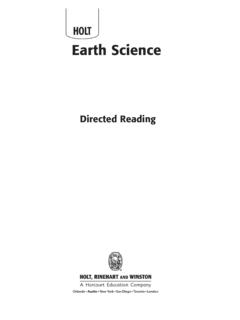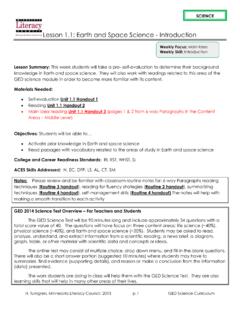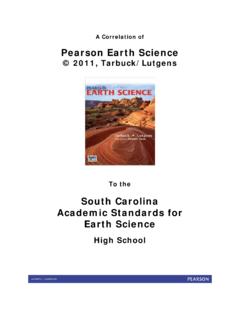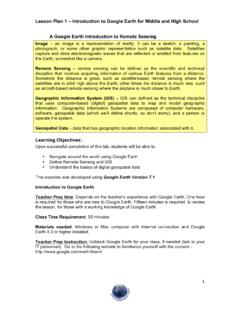Transcription of Introduction - Earth Science
1 1 Released Test QuestionsEarth ScienceThis is a sample of California Standards Test questions. This is NOT an operational test form. Test scores cannot be projectedbased on performance on released test questions. Copyright 2004 California Department of STANDARDS TESTI ntroduction - Earth ScienceThe following released test questions are taken from the Earth Science Standards Test. This test is one of theCalifornia Standards Tests administered as part of the Standardized Testing and Reporting (STAR) Programunder policies set by the State Board of questions on the California Standards Tests are evaluated by committees of content experts, including teachersand administrators, to ensure their appropriateness for measuring the California academic content standards in EarthScience.
2 In addition to content, all items are reviewed and approved to ensure their adherence to the principles offairness and to ensure no bias exists with respect to characteristics such as gender, ethnicity, and document contains released test questions from the California Standards Test forms in 2003 and on the pages that follow are lists of the standards assessed on the Earth Science Test. Next are releasedtest questions. Following the questions is a table that gives the correct answer for each question, the contentstandard that each question is measuring, and the year each question last appeared on the test. It should benoted that asterisked (*) standards found in the Science Content Standards for California Public Schools,Kindergarten through Grade 12, are not assessed on the California Standards Tests in Science and, therefore,are not represented in these released test following table lists each reporting cluster, the number of items that appear on the exam, and the numberof released test questions that appear in this document.
3 The released test questions for Biology, Chemistry, Earth Science , and Physics are the same test questions found in different combinations on the IntegratedScience 1, 2, 3, and 4 tests. 2 Earth ScienceReleased Test QuestionsThis is a sample of California Standards Test questions. This is NOT an operational test form. Test scores cannot be projectedbased on performance on released test questions. Copyright 2004 California Department of STANDARDS TESTNUMBER OFNUMBER OFREPORTING CLUSTERQUESTIONSRELEASEDON EXAMTEST QUESTIONSI nvestigation and Experimentation(Standards: ESIE1. a-n)63 Astronomy and CosmologyEarth s Place in the Universe (Standards: ES1. a-f, ES2.)
4 A-d)127 Solid EarthDynamic Earth Processes (Standards: ES3. a-e)California Geology (Standards: ES9. a-c)148 The Earth s EnergyEnergy in the Earth System (Standards: ES4. a-c, ES5. a-e, ES6. a-c)Biogeochemical Cycles (Standards: ES7. a-c)Structure and Composition of the Atmosphere (Standards: ES8. a-c)2812 TOTAL6030In selecting test questions for release, three criteria are used: (1) the questions adequately cover a selection of theacademic content standards assessed on the Earth Science Test; (2) the questions demonstrate a range of difficulty;and (3) the questions present a variety of ways standards can be assessed. These released test questions do not reflectall of the ways the standards may be assessed.
5 Released test questions will not appear on future more information about the California Standards Tests, visit the California Department of Education sWeb site at 3 Released Test QuestionsEarth ScienceThis is a sample of California Standards Test questions. This is NOT an operational test form. Test scores cannot be projectedbased on performance on released test questions. Copyright 2004 California Department of STANDARDS TESTTHE INVESTIGATION AND EXPERIMENTATION REPORTING CLUSTERThe following 14 California content standards are included in the Investigation and Experimentation reportingcluster and are represented in this booklet by three test questions.
6 These questions represent only some ways inwhich these standards may be assessed on the California Earth Science Standards CONTENT STANDARDS IN THIS REPORTING CLUSTERI nvestigation and progress is made by asking meaningful questions and conductingcareful investigations. As a basis for understanding this concept and addressingthe content in the other three reporting clusters, students should develop theirown questions and perform investigations. Students will:ESIE1. and use appropriate tools and technology (such as computer-linked probes,spreadsheets, and graphing calculators) to perform tests, collect data, analyzerelationships, and display and communicate sources of unavoidable experimental possible reasons for inconsistent results, such as sources of error or explanations by using logic and scientific problems by using quadratic equations and simple trigonometric,exponential, and logarithmic between hypothesis and theory as scientific the usefulness and limitations of models and theories as scientificrepresentations of and interpret topographic and geologic the locations, sequences, or time intervals that are characteristic of naturalphenomena ( , relative ages of rocks.)
7 Locations of planets over time, and succession ofspecies in an ecosystem).ESIE1. the issues of statistical variability and the need for controlled the cumulative nature of scientific situations and solve problems that require combining and applying conceptsfrom more than one area of m. Investigate a Science -based societal issue by researching the literature, analyzing data,and communicating the findings. Examples of issues include irradiation of food, cloning ofanimals by somatic cell nuclear transfer, choice of energy sources, and land and wateruse decisions in that when an observation does not agree with an accepted scientific theory, theobservation is sometimes mistaken or fraudulent ( , the Piltdown Man fossil orunidentified flying objects) and that the theory is sometimes wrong ( , the Ptolemaicmodel of the movement of the Sun, Moon, and planets).
8 4 Earth ScienceReleased Test QuestionsThis is a sample of California Standards Test questions. This is NOT an operational test form. Test scores cannot be projectedbased on performance on released test questions. Copyright 2004 California Department of STANDARDS TESTTHE ASTRONOMY AND COSMOLOGY REPORTING CLUSTERThe following 10 California content standards are included in the Astronomy and Cosmology reporting clusterand are represented in this booklet by seven test questions. These questions represent only some ways in whichthese standards may be assessed on the California Earth Science Standards CONTENT STANDARDS IN THIS REPORTING CLUSTERE arth s Place in the and planetary exploration reveal the solar system s structure, scale,and change over time.
9 As a basis for understanding this concept:ES1. know how the differences and similarities among the sun, the terrestrial planets,and the gas planets may have been established during the formation of the solar know the evidence from Earth and moon rocks indicates that the solar systemwas formed from a nebular cloud of dust and gas approximately billion years know the evidence from geological studies of Earth and other planets suggeststhat the early Earth was very different from Earth know the evidence indicating that the planets are much closer to Earth than thestars know the Sun is a typical star and is powered by nuclear reactions, primarily thefusion of hydrogen to form know the evidence for the dramatic effects that asteroid impacts have had inshaping the surface of planets and their moons and in mass extinctions of life on and space-based astronomy reveal the structure, scale, and changesin stars, galaxies, and the universe over time.
10 As a basis for understanding thisconcept:ES2. know the solar system is located in an outer edge of the disc-shaped Milky Waygalaxy, which spans 100,000 light know galaxies are made of billions of stars and comprise most of the visiblemass of the know the evidence indicating that all elements with an atomic number greaterthan that of lithium have been formed by nuclear fusion in know that stars differ in their life cycles and that visual, radio, and X-raytelescopes may be used to collect data that reveal those differences. 5 Released Test QuestionsEarth ScienceThis is a sample of California Standards Test questions. This is NOT an operational test form.









